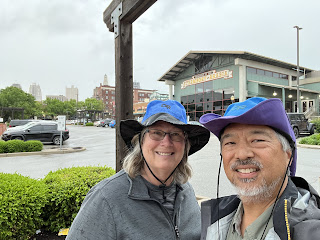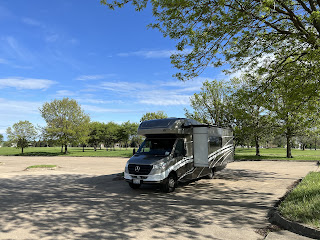Sunday May 15, 2022; Oronogo, Kansas City MO, Des Moines IA
We awoke with the sounds of the neighbors’ peacocks trumpeting the start of a new day. We packed up and reconfigured the RV for travel, and bid our farewells to Gloria and John.
Gloria had thoughtfully made us a pan of breakfast casserole (egg, biscuit, sausage and cheese-YUM) and a pan of chocolate cake to go, as well as a thermos of fresh brewed coffee. There’s nothing quite like Midwest hospitality.
It was sunny with clear blue skies overhead and the temperature was in the 70’s when we left Gloria and John’s place, but we could see a weather system with some ominous dark clouds passing from west to east ahead in the northern skies. Gloria and John had advised us that we were going to be dancing with a potentially dangerous storm cell moving through the state.
They pointed us to an app (KOAM pinpoint weather) that they use to track severe weather when traveling, and it was very useful to see where the most severe rain, lightning and hail were relative to our itinerary with realtime radar.
As we headed north, we were fortunate to end up with the most severe weather passing to the east and south of us.
We did encounter some heavy rain and winds for about a half hour, but that did wash some of the dead bugs off the RV for us. We had passed a couple of motorcyclists taking shelter under the few underpasses we drove by in the weather. The underpasses were very narrow and there was only room on the shoulder for a single vehicle under each underpass in each directions, so it’s a good thing we didn’t encounter any hail.
We refueled in Harrisonville MO, taking on 19.154gal @$5.099/gal with 24102 miles on the odometer (12.9mpg).
We arrived at the Steamboat Arabia Museum situated in downtown Kansas City Missouri, adjacent to the City Market, at about 11am.
It was raining and the museum didn’t open until noon. We were very fortunate to find a parking space on the street just outside the pay parking lot for the museum, and the parking attendant working in the pay lot told us parking on the street is free on weekends, despite the signage suggesting that we pay through a smartphone app. So we really lucked out on finding free parking so close to museum.
We walked through the City Market, which is very much like the Pikes Place Market in Seattle. There are a number of restaurants and food stalls, as well as ethnic stores (Italian, Arab, Indian), and many stall selling fruits, vegetables, flowers and plants.
Walking through the ethnic stores was very interesting, and the Arab and Indian stores were particularly filled with interesting smells and colors because they each had extensive sections with bulk spices, herbs, seasonings, dried fruits and other dried goods.
We were some of the first people in the museum which does a good job of introducing visitors to the history of the steamboat Arabia.
The boat was one of a vast fleet of steam powered paddle wheelers that sailed the Missouri River in the mid 1800’s from before the civil war for about 30 years. Most had a fairly short life span. They were work horses of commerce taking people and supplies from population hubs along the Mississippi and Missouri rivers upstream to the western frontier.
These steam ships were fueled with wood that was cut from trees along the banks of the rivers. Storms would wash stumps and deadheads into the river which formed invisible underwater hazards. One of these, a sycamore snag, speared through the bow of the Arabia in 1856, sinking it with most of its valuable cargo. All of the passengers escaped with their lives, but a mule that had been tied to some equipment destined for a saw mill on the deck went down with the ship.
The muddy bottom and river currents claimed the ship, and as the course of the Missouri River changed over the years, the ship eventually came to be located inside a river bend in the middle of a farmer’s field under 40’ of dirt and mud.
A salvage attempt was made in 1897 by a team of men who had hoped to recover a purported treasure of whiskey kegs. They used a metal column that was pressurized to push out the ground water (pneumatic caisson) as they excavated downwards onto the deck of the boat. They found a few barrels of boots and hardware goods, but no whiskey.
The wreck remained buried until an enterprising group of men looking for a bit of adventure, decided to excavate the steam ship. They used magnetometers and exploratory drilling to locate the ship, and then sunk deep wells to pump out the ground water and keep the excavation site dry enough to work in. These wells pumped up to 20,000 gal per day to keep the site dry.
There was no treasure on whiskey, but they did find the largest collection of pre-civil war American artifacts representing live on the river and frontier exploration. They have done painstaking restoration and have kept the collection intact as a museum rather than selling it off.
They have restored one of the steam engines and paddle wheels to demonstrate how those worked, and have the boilers and a portion of the ship’s stern and rudder on display, along with many display cases showing the cargo and passenger belongings that were salvaged in the excavation, from the smallest trade beads to saw mill and printing press equipment. There was a lot of fine imported china, and some ornate gold plated powder horns.
There are huge display cases full of hardware, tools, household goods and everything needed to open a fully stocked frontier general store.
There were also intact cases of pickled vegetables and all manner of bottled goods including wine, champagne, elixirs and spirits.
The museum is very well done and worth a visit if you find yourselves in Kansas City, Missouri.
We then headed north to Des Moines, Iowa. The storm cells had moved to the southeast and the sky cleared. Temperatures during the storm had dropped into the upper 60’s but by afternoon, they were back in the mid to upper 70’s.
We were thinking of boondocking at a Bass Pro shop in Altoona, a suburb of Des Moines, but a quick consultation with the Harvest Hosts app showed there was a Living History Farm museum right on I-35 in Urbandale. We pulled into the deserted parking lot at 5pm. The Harvest Host app informed us that they take same day requests and also noted that although the museum was closed , guests were welcome to stay in the parking lot.
We were the only vehicle in the nearly 5 acre parking lot, but we were surrounded by Canada geese both on the pavement and on the surrounding grounds. We also saw some deer and a fox on the edges of the parking lot.
We zoomed with our kids using AT&T cellular service and then relaxed watching some local TV over the air broadcasts which informed us that there was a total lunar eclipse happening at 10:30pm. We had a perfect view of that from the parking lot.
The museum is closed tomorrow, so we will continue north to visit Ben’s brother Arthur in Rochester MN. The weather should be cooler, so there will be no need to run the generator for air conditioning. The furnace works, but there still seems to be a propane leak somewhere, perhaps at the manifold where the main gas line gets distributed to the various appliances and auxiliary connection. Unfortunately, that manifold is not mounted in an easily accessible area. Ben had tried to access it using hand tools from the passenger side wheel well, but this will have to wait until we get the RV back into the barn where the RV can be jacked up to work in that area better.






















